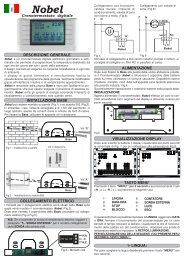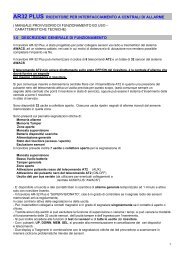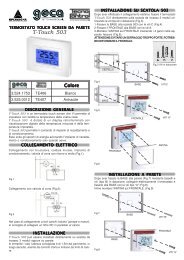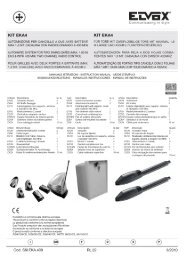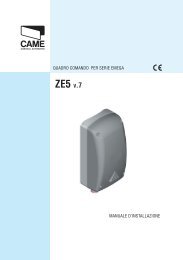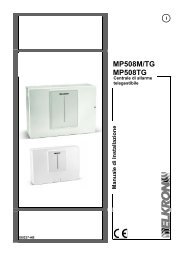Applications examples - Mgelettroforniture
Applications examples - Mgelettroforniture
Applications examples - Mgelettroforniture
You also want an ePaper? Increase the reach of your titles
YUMPU automatically turns print PDFs into web optimized ePapers that Google loves.
SICUREZZA<br />
GAS - GAS DETECTION<br />
Esempi applicativi<br />
<strong>Applications</strong> <strong>examples</strong><br />
94<br />
PRODOTTI DA USARE<br />
PRODUCTS TO USE<br />
Rilevazione CO<br />
CO detection<br />
Rilevazione NH 3<br />
NH 3<br />
detection<br />
Rilevazione CH 4<br />
CH 4<br />
detection<br />
Rilevazione C 2<br />
HC1 3<br />
C 2<br />
HC1 3<br />
detection<br />
TS292P<br />
TS293P<br />
TS220EA-H<br />
TS293EA-H<br />
SE138PM<br />
TS292PM<br />
TS293PM<br />
TS220EX<br />
TS293P<br />
Trattamento termico dei metalli<br />
Metals thermal treatment<br />
Gas presenti<br />
Infiammabili: Sono utilizzati diversi solventi per la pulizia dei macchinari e per la combinazione ai<br />
metalli dipendentemente dal risultato voluto.<br />
Ossido di Carbonio (CO): Nei trattamento termici (tempere, indurimento metalli) si opera<br />
normalmente in forni in atmosfere controllate a base di ossido di carbonio.<br />
Ammoniaca(NH 3<br />
): Sostanza molto presente nelle “ricette” per il trattamento termico.<br />
Metano (CH 4<br />
): Il combustibile più usato per ottenere le temperature necessarie al trattamento.<br />
Tricloetilene (C 2<br />
HCl 3<br />
): Il tricloroetilene è una sostanza nociva per via inalatoria e può determinare<br />
effetti irreversibili. Uno dei suoi organi bersaglio è il fegato.<br />
Rischio atteso<br />
Infiammabili: A concentrazioni rispetto al volume anche inferiori al LEL, esplode con minime fonti<br />
d’innesco con conseguenze spesso gravi per persone e cose.<br />
CO: Il monossido di carbonio è un gas compresso inodore, incolore, insapore e velenoso. Anche<br />
basse esposizioni al monossido di carbonio possono ridurre la concentrazione di ossigeno nel<br />
cervello al punto che la vittima diventa incosciente e muore.<br />
NH 3<br />
: incolore, di odore irritante e pungente, infiammabile, tossico. L’ammoniaca ha azione irritante<br />
sulle mucose della congiuntiva, delle narici e della faringe a funzione ustionante. L’ammoniaca ha<br />
inoltre effetto ustionante.<br />
CH 4<br />
: Gas incolore ma con un pungente forte odore sulfureo originario dall’additivazione in origine.<br />
E’ fortemente infiammabile e se disperso in quantità anche piccole rispetto al volume potrebbe<br />
dare luogo ad esplosioni.<br />
C 2<br />
HCl 3<br />
: Il tricloroetilene è una sostanza nociva per via inalatoria e può determinare effetti irreversibili.<br />
Uno dei suoi organi bersaglio è il fegato.<br />
GASES INVOLVED<br />
Flammable gases: different solvents are used to clean machines and matching metals depending<br />
on the result required.<br />
Carbon oxide (CO): thermal treatments (metal hardening and tempering) generally take place in<br />
carbon-oxide-based controlled-atmosphere furnaces.<br />
Ammonia (NH3): very common substance in “recipes” for thermal treatments.<br />
Methane (CH4): the most commonly used fuel to reach the temperature required for thermal<br />
treatments.<br />
Trichloroethylene (C2HCl3): it is an hazardous substance if inhaled and can cause irreversible<br />
diseases. One of its target organs is liver.<br />
EXPECTED RISKS<br />
Inflammable gases: in smaller concentration even than LEL with regard to the volume they<br />
explode in presence of a minimum flash source often resulting in serious consequences for people<br />
and things.<br />
CO: carbon dioxide is a compressed colourless, odourless, tasteless and poisonous gas. Even<br />
short exposures to carbon dioxide may reduce oxygen concentration in brain so the victim falls<br />
unconscious and dies.<br />
NH 3<br />
: colourless, with an irritating, sharp smell, inflammable, toxic. Ammonia irritates the mucosa of<br />
the conjunctiva, nostrils and pharynx through a scalding action. Moreover, ammonia has a general<br />
scalding action.<br />
CH 4<br />
: methane is a simple hydrocarbon and is in nature in form of gas. Methane is the main<br />
component of natural gas and is an excellent fuel, able to form easily in atmosphere resulting in a<br />
high risk of explosion.<br />
C 2<br />
HCl 3<br />
: trichloroethylene is an hazardous substance for the breathing system and may cause<br />
irreversible effects. One of its target organs is liver.




